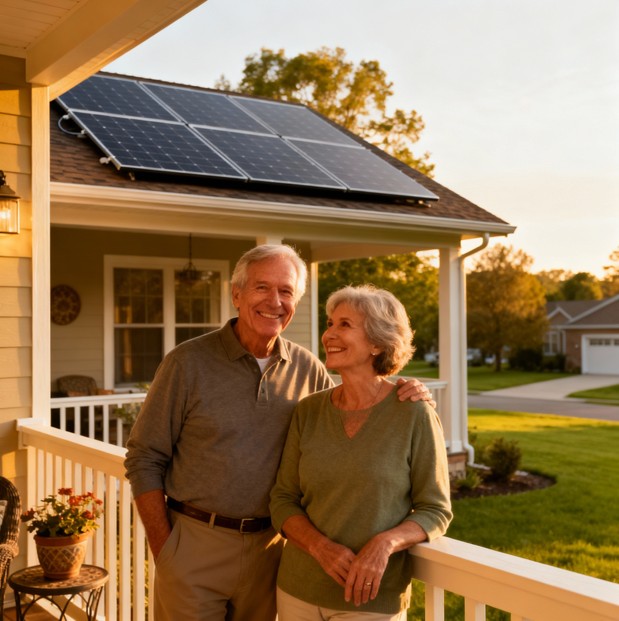Retirement planning conversations typically revolve around RRSPs, pensions, and maybe downsizing the house. Nobody brings up residential solar panel installation for fixed-income energy savings at book club or during coffee hour. Yet increasingly, savvy retirees are discovering that strategic solar panel installation for retirement cost reduction represents one of the smartest financial moves they never saw coming. The monthly utility bill that seemed manageable during working years suddenly feels like a leak in the retirement ship when living on fixed income. Meanwhile, neighbors who made the solar switch three years ago keep casually mentioning their $11 electric bill in July while everyone else complains about air conditioning costs.
The shift happening quietly across retirement communities reflects changing attitudes about what constitutes sound financial planning for the golden years. Understanding how solar power integrates with sustainable lifestyle choices reveals why design-conscious mature adults no longer view panels as industrial eyesores but rather symbols of financial independence. Similarly, AARP’s guidance on solar energy decisions demonstrates how mainstream publications serving mature audiences now treat solar as practical retirement planning rather than environmental activism.
Let’s address the questions most people don’t think to ask until after they’ve already signed contracts or worse, missed opportunities entirely.
Q: Isn’t solar too expensive for someone on a fixed income?
This might be the most common objection, and it’s based on looking at upfront costs without considering the complete financial picture. Think of it like this: you’re already paying for electricity, you just pay monthly instead of upfront. The average retired Canadian household spends $150-200 monthly on electricity. Over 25 years, that’s $45,000 to $60,000, assuming rates never increase (spoiler: they always do).
A typical solar system costs $20,000-30,000 before incentives. Federal tax credits cover 30% of installation costs. Provincial and utility incentives often reduce net investment further. For someone who worked decades and understands compound interest, the math becomes compelling. You’re essentially pre-paying electricity costs at today’s rates rather than gambling on what utilities will charge over the next 25 years.
The financing evolution makes this even more accessible. Zero-down payment options, low-interest green energy loans, and power purchase agreements where you pay only for energy produced all eliminate the barrier of large upfront payments. Some retirees use home equity lines of credit at today’s favorable rates, essentially refinancing their utility payments into a fixed asset that increases home value.
Q: Will I even live long enough to see the payback?
This question assumes payback happens decades into the future, which doesn’t match current reality. Most systems reach break-even in 8-12 years, depending on location and electricity rates. For retirees in their 60s or even early 70s, that timeline fits comfortably within statistical life expectancy. More importantly, savings begin immediately, not at some distant payback point.
Month one after installation, the electric bill drops. That’s real money staying in the budget for travel, grandchildren, hobbies, or simply creating the breathing room that makes fixed income less stressful. The payback calculation measures when cumulative savings exceed initial investment, but the quality-of-life benefit of lower monthly expenses starts day one.
Plus, thinking purely in terms of personal payback ignores property value considerations. Homes with solar systems sell faster and command premium prices. If downsizing becomes necessary before payback completes, the increased home value typically recovers most or all of the solar investment while the new buyer enjoys the remaining years of free electricity.
Q: What happens if I need to replace my roof?
Excellent question that too few people ask during consultations. Solar panels last 25-30 years with warranties to match. If your roof needs replacement within the next 5-10 years, combining both projects makes tremendous sense. Yes, it increases upfront costs, but you avoid the expensive hassle of removing and reinstalling panels later.
Quality installers inspect roofs before quoting and recommend addressing needed repairs or replacements first. This protects both parties. The company avoids installation on roofs that will fail prematurely, and homeowners avoid the nightmare scenario of needing roof work with panels in the way.
For roofs in good condition expected to last 15-20+ years, proceed with confidence. Modern mounting systems allow panel removal if unexpected roof repair becomes necessary, though this adds expense and inconvenience best avoided through proper planning.
Q: Aren’t solar panels an eyesore in the neighborhood?
This concern made sense 20 years ago when panels resembled science projects gone wrong. Today’s solar installations feature sleek black profiles that integrate cleanly with roof lines. Many neighbors won’t even notice until you mention them. Some high-end options match roof colors so seamlessly that only careful inspection reveals their presence.
The aesthetic evolution reflects both technological advancement and changing cultural perceptions. Solar panels have transitioned from “weird environmental statement” to “smart financial choice that happens to benefit the environment.” In many retirement communities, seeing panels on rooftops has become as normal as seeing well-maintained gardens, another sign of homeowners who care about their property and long-term planning.
For neighborhoods with strict aesthetic requirements, solar shingles and tiles replace traditional roofing materials entirely, functioning as both roof covering and power generation. These building-integrated options cost more but deliver the ultimate in visual integration for those who prioritize appearance alongside performance.
Q: What about maintenance and repairs?
This might be the best news in the entire solar story: maintenance requirements prove remarkably minimal. Rain handles most cleaning naturally. Occasional manual cleaning in dusty areas or after storms helps maintain peak efficiency, but we’re talking about hosing off panels a few times yearly, not intensive ongoing care that becomes burdensome as mobility decreases with age.
The lack of moving parts means minimal wear and mechanical failures. Unlike furnaces, air conditioners, or other complex home systems requiring regular service, solar panels just sit there quietly converting sunlight into electricity year after year. Inverters might need replacement once during the system’s lifespan, typically a straightforward service call rather than major expense.
Monitoring systems alert homeowners immediately to performance issues, allowing prompt attention before problems impact energy production significantly. Many companies offer monitoring apps showing real-time generation, making invisible electricity production visible and even enjoyable to track.
Q: Can I really go off-grid and thumb my nose at the utility company?
Technically possible, practically inadvisable for most situations. Complete off-grid systems require substantial battery storage to cover nighttime use and cloudy periods. The battery costs and replacement cycles make this approach expensive and complex compared to remaining grid-connected while dramatically reducing dependence.
Grid-tied systems with battery backup offer the best compromise. You maintain grid connection for reliability and convenience while batteries provide backup power during outages. This proves particularly valuable for retirees who might have medical equipment requiring reliable electricity or simply want the security of knowing power will remain available during storms that leave grid-dependent neighbors in the dark.
Net metering programs available in most provinces allow selling excess solar production back to utilities for credits against nighttime or winter consumption. This essentially uses the grid as a giant battery without the cost and complexity of physical battery storage, maximizing financial benefit while maintaining simplicity.
Q: What if we want to downsize in a few years?
Solar installations typically increase home values by amounts approximating or exceeding installation costs, making this a non-issue for most sellers. Homes with solar systems sell faster than comparable homes without them, particularly as younger buyers increasingly prioritize sustainability alongside other home features.
Multiple studies confirm that buyers pay premiums for solar-equipped homes, recognizing the long-term value of reduced energy costs already locked in. The premium buyers pay typically reflects remaining savings available, essentially giving sellers their investment back while they enjoyed years of reduced bills before selling.
For those certain they’ll downsize within 2-3 years, solar makes less sense regardless of age. The technology and financing work beautifully, but basic investment logic requires reasonable time horizons. Anyone planning to remain in their home 5+ years enters the sweet spot where solar delivers both immediate monthly savings and excellent long-term value.
Q: Isn’t this just for environmental activists?
Environmental benefits accompany solar installation whether they motivated the decision or not, but the overwhelming majority of retirees choose solar for straightforward financial reasons. Reduced monthly expenses on fixed income, protection against rising utility rates, and increased home values drive adoption far more than saving polar bears or reducing carbon footprints.
That said, many retirees discover they value the environmental impact more than anticipated once installation happens. Watching monitoring apps show daily CO2 reductions and fossil fuel displacement creates unexpected satisfaction. For grandparents wanting to model environmental responsibility, solar provides visible daily demonstration that sustainable choices don’t require sacrifice or hardship.
The beauty lies in alignment between financial self-interest and environmental benefit. Both work together rather than requiring trade-offs. Saving money while reducing environmental impact proves more compelling than either factor alone.
Q: Will solar panels work through Canadian winters?
Germany leads the world in solar adoption despite having less annual sunshine than many Canadian cities. Modern panels generate electricity from daylight, not just direct sun, meaning they produce power even on overcast days. Snow accumulation can temporarily reduce production, but panels’ dark surfaces and roof angles encourage sliding once accumulation stops.
The cold actually benefits solar panel efficiency. Panels perform better in cold temperatures than heat, partly offsetting reduced daylight hours during winter months. Annual production accounts for seasonal variations, with summer surplus often compensating for reduced winter generation through net metering credits.
Professional installers use sophisticated tools analyzing your specific location’s sun exposure patterns, accounting for local weather, seasonal variations, and potential shading. If they recommend solar for your location, trust that projections account for real-world climate rather than ideal conditions. Nobody benefits from overselling systems that underperform expectations.
Q: Should we do this before or after the tax credit changes?
Federal solar tax credits currently sit at 30% of installation costs, representing substantial savings for those with sufficient tax liability to claim them. The credit’s future depends on political decisions, creating urgency for those able to benefit now.
Many retirees discover they can’t claim the full credit immediately due to reduced taxable income. The credit can carry forward to future tax years, potentially benefiting from continued RRSP withdrawals or other taxable income. Consulting with tax advisors helps determine personal eligibility and optimal timing.
For those unable to claim tax credits directly, solar leases or power purchase agreements allow third-party owners to claim credits while passing some savings to homeowners through reduced monthly payments. This makes solar accessible even for those without tax liability to offset.
What retired people never regret (but often postpone too long)
The consistent pattern among retirees who installed solar years ago isn’t just satisfaction with the decision. It’s regret about not doing it sooner. Those monthly electric bills that seemed tolerable at the time add up to thousands in retrospect that could have funded additional travel, helped grandchildren, or simply created more financial breathing room during years when every dollar matters.
Solar technology will continue improving, but waiting for perfect options means never benefiting from excellent current options available today. The panels on your roof in 2025 will produce electricity and save money in 2026, 2030, and 2045. The panels you postpone installing will save exactly nothing while you wait for the next generation that will also eventually get surpassed by future improvements.
For mature adults who’ve spent decades making smart financial decisions, solar represents another opportunity to think strategically about long-term value rather than short-term cost. The upfront investment feels significant, but context matters: it’s smaller than many paid for vehicles that depreciated to nothing within 10 years. Solar systems maintain value, provide ongoing returns, and deliver the rare satisfaction of watching a major purchase pay dividends month after month for decades.
The retirement years should bring freedom from financial stress, not new worries about affording basic utilities. Solar offers a practical path toward that freedom, turning a monthly expense into a fixed asset while the sun does all the work.







